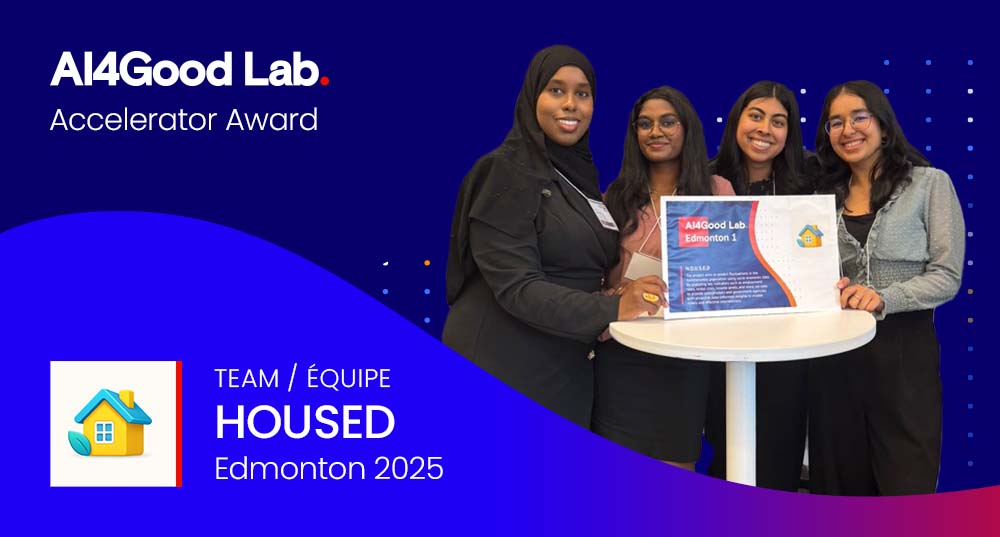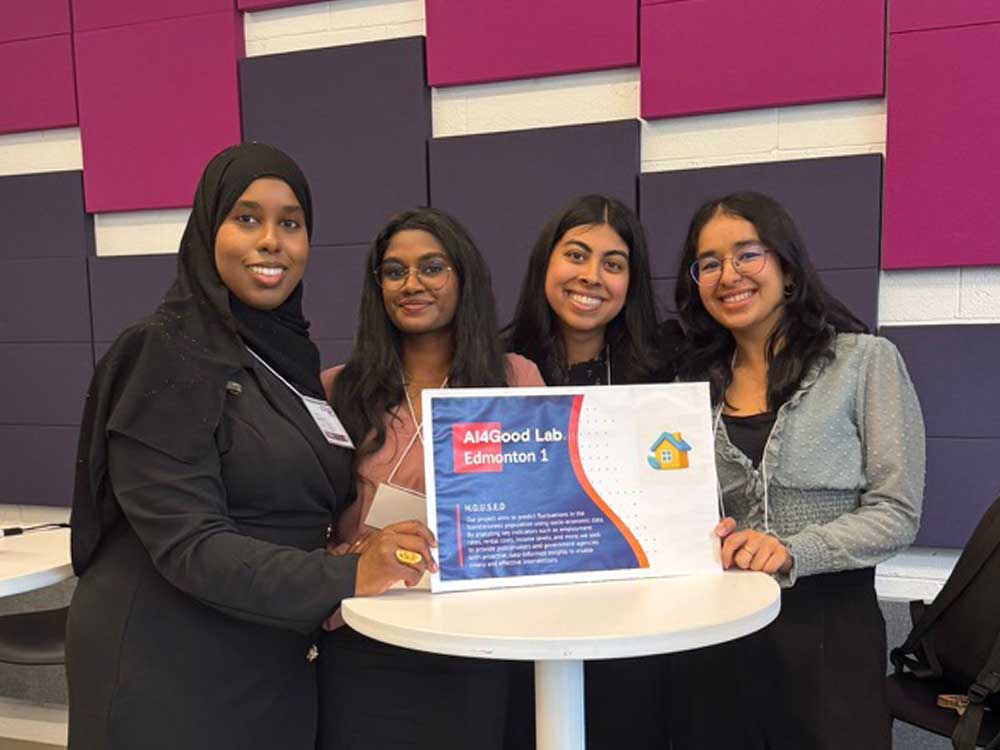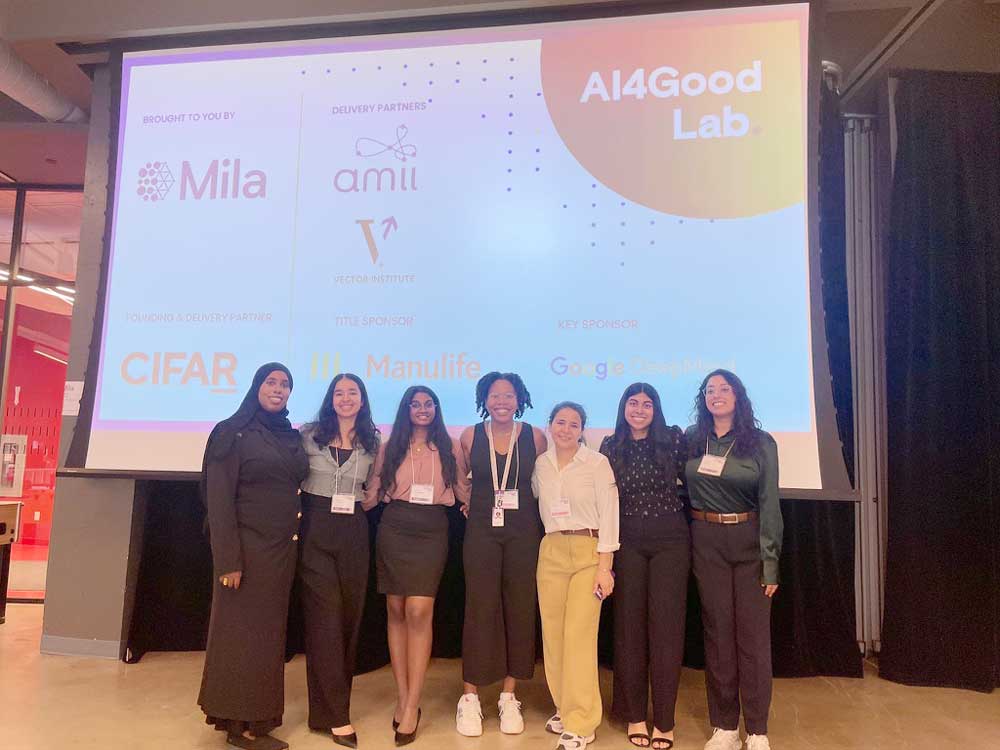
Team members
Sohana Dhinsa, Salma Ibrahim, Mehak Sahjwani, Sneha Latha Parasuraman
Project summary
HOUSED is a machine learning simulation tool designed to help policymakers and homeless shelters accurately forecast the number of individuals experiencing homelessness in the coming year. By providing data-driven predictions, HOUSED enables proactive planning and informed decision-making to better allocate resources and improve support services.
Keywords
Homelessness, Regression, Data-Driven predictions, Forecasting
Presentation

Inspiration
Homelessness is a growing and urgent issue in Edmonton and across Canada, one that cannot be explained by a single factor, but rather a complex web of social and economic challenges. According to the Everyone Counts 2020–2022 report from the Government of Canada, unsheltered homelessness increased by 88%, underscoring the worsening severity of this crisis. Contributing challenges include inequitable access to resources, unreliable assessment tools, ineffective intervention strategies, and difficulties in matching individuals with appropriate housing, as noted in recent critiques of coordinated access systems (Coordinated Access and Coordinated Entry System Processes in the Housing and Homelessness Sector: A Critical Commentary on Current Practices).
These systemic shortcomings are not just numbers, they represent lives. Without access to safe housing or support, people are forced to cope with trauma, poverty, mental illness, addiction, or even serious illnesses while also facing discrimination, racism, and criminalization. Too often, individuals are assessed as “undesirable, risky, or difficult to work with,” and many have even come to identify as homeless, believing the system itself is keeping them where they are: “People have accepted where they are, they live on the street, they identify as homeless. They see the system is keeping them where they are and it’s hard to convince them to move on.” (Quirouette, M. (2016). Managing Multiple Disadvantages)
This issue is further compounded by limited and inconsistent data collection, leaving policymakers, frontline workers, and service providers without the tools to respond effectively. As a result, too many continue to fall through the cracks facing nights without shelter, families living in uncertainty, and individuals left without the dignity of a safe place to call home. Our project is not just about analyzing data, it is about policy makers using insights from socio-economic trends to support timely, informed decisions that help people apart of the homeless population.
List of technologies
- Languages & Frameworks: Python (Pandas, NumPy, Scikit-Learn, Matplotlib, Seaborn)
- Development Environment: Jupyter Notebook
- Data Sources: City of Edmonton Open Data Portal, CMHC, Alberta Government datasets
- Version Control & Collaboration: Google Docs, Google Collab, Notion
Project development
The project development for HOUSED was divided into three distinct phases. The first began with ethics research and meetings with stakeholders. Members of our team spent time reaching out to homeless shelters and charities while seeking an ethics council to appropriately handle and consider the subject matter. We visited shelters in our area to speak with those who work firsthand in addressing the homelessness epidemic in our city.
The second phase focused on data collection. We gathered data from credible sources such as the Government of Alberta, the Federal Government, Statistics Canada, the Canadian Homelessness Council, and others. We sought out data on poverty rates, unemployment rates, vacancy rates, and processed all our data into a time series dataset suitable for our model.
Finally, we entered the modeling phase. Here we used a linear regression model to predict fluctuations in the homeless population under potential economic climates. For example, our main stakeholders, policy makers, could use our tool to see how a future 10% increase in poverty rates and a potential 15% decrease in employment may increase homelessness by X number of individuals. HOUSED proves to be a unique approach to dealing with homelessness by leveraging AI models to do scenario forecasting.
Impact/Innovation
We discovered a lack of solutions for addressing homelessness and the ones that do exist are reactive measures for dealing with the growing homeless population. What makes our project HOUSED unique is that we take a proactive approach by using machine learning predictions to give policy makers insight to create impactful initiatives and guidelines to help the current homeless population. We designed our model to identify which specific socioeconomic factors have the greatest impact on homelessness, giving decision-makers clear, actionable insights for assisting the homeless population. Instead of relying on black-box models, we used a linear regression approach so policymakers can easily understand how each factor contributes to the predictions, making the results transparent, accessible, and directly useful for creating informed policies.
Challenges
Our most significant challenge was collecting reliable, accurate, and sufficient data to train the model. Many datasets were incomplete, outdated, or inconsistent with our requirements. Rather than fabricating or inflating the dataset, we prioritized quality over quantity, and proceeded with trustworthy data. Another major data-related challenge was deciding which socio-economic factors to include. To address this, we conducted a detailed analysis of each available factor, examining its correlation with homelessness to identify trends, and carefully selected the most impactful variables to create an accurate and reliable dataset.
Another key challenge was navigating the ethical considerations tied to both the data and the project’s real-world impact. We held meetings with Rose Landry, Manager of AI Governance and Legal Affair at Mila, to discuss potential risks and mitigation strategies. We also conducted thorough research into best practices for ethical AI and engaged in conversations with individuals at homeless shelters, representatives from the government sector, and NGOs working directly with homeless populations. These interviews provided us with diverse perspectives into the lived experiences of the people our project aimed to support, ensuring our approach was informed and responsible.
On the technical side, one of our major hurdles was encoding the “years” feature into our linear regression model, since a standard linear regression model does not inherently understand the progression of time. After consulting with our mentor and teaching assistant, we decided to use lag features to represent time progression effectively. Additionally, we experimented with alternative models, including LSTM and Random Forest, to see if accuracy could be improved. In the end, the linear regression model outperformed the others, providing the highest accuracy for our dataset.
What we learned and accomplished
This project pushed us to grow both technically and as a team. On the technical side, we explored different machine learning concepts, learned their strengths and limitations, and implemented linear regression with careful feature engineering, residual analysis, and lag variables to improve predictions.
Working together was one of the best parts: we had a highly collaborative team where everyone contributed their strengths, from data preparation to modeling to outreach. A big milestone was meeting with local homeless shelters, which gave us real-world insight and validated that our model’s predictions reflected actual trends.
Most importantly, we learned the ethical responsibility that comes with doing data science for social issues. We focused on being transparent so people could understand how the predictions were made, worked to minimize bias in the data, and always kept in mind that every data point represents a real person. That perspective guided every decision we made in the project.
What’s next for the project
We each loved our time together building this wonderful project. It has been a great journey as it showed us the positive impact AI and Machine learning can have. We also found that a great team can create a great project and we have learned so much from each other, allowing us to grow as individuals and as a team. This project, this team and this lab will always hold a special place in our hearts.

Acknowledgements & References
Acknowledgements:
This project would not have been possible without the help and guidance of so many amazing people. Firstly, we would like to thank our TA Rohini Das and mentor Rafael Madrigal, who advised us at every step and provided invaluable feedback throughout the project. We also extend our gratitude to our other TAs Afia Afrin and Jake Tuero, as well as James Dang, Product Manager at Amii, and Rose Landry, Manager of AI Governance and Legal Affairs at Mila, for their insights and expertise.
We are grateful to Jennifer Addison, Yorsa Kazemi, Juliana Virani, Erika Hudon-Kaide, Warren Johnston and everyone who supported this program, as well as Kashish Aggarwal for her invaluable advice and the Amii staff who patiently heard our pitch with unwavering support. Additionally, thank you to Heba Iftikhar and Jean Bruce Koua for the assistance in connecting us to the right people. We also deeply appreciate the conversations with Brett Case, a Director of Housing Supports and Jennifer Legate, a Manager of Program Policy Initiatives from the Government of Alberta. As well as Dan Zimmerman, a Community Lead from Boyle Street.
Finally, we offer heartfelt thanks to CIFAR, Google DeepMind, Mila - Quebec Artificial Intelligence Institute, Alberta Machine Intelligence Institute (Amii), Vector Institute, Manulife, Osmo, and all other sponsors for making this opportunity possible.
References:
- Ecker, J., Brown, M., Aubry, T., Pridham, K. F., & Hwang, S. W. (2022). Coordinated Access and Coordinated Entry System Processes in the Housing and Homelessness Sector: A Critical Commentary on Current Practices. Housing Policy Debate, 32(6), 876–895. https://doi.org/10.1080/10511482.2022.2058580
- Ahajumobi, E. N. (2017). Homelessness in Calgary From the Perspectives of Those Experiencing Homelessness (Order No. 10641408). Available from Canadian Business & Current Affairs Database; ProQuest Dissertations & Theses Global. (2002280126). https://login.ezproxy.library.ualberta.ca/login?url=https://www.proquest.com/dissertations-theses/homelessness-calgary-perspectives-those/docview/2002280126/se-2
- Quirouette, M. (2016). Managing Multiple Disadvantages: The Regulation of Complex Needs in Emergency Shelters for the Homeless. Journal of Poverty, 20(3), 316–339. https://doi.org/10.1080/10875549.2015.1094774
- Canada Mortgage and Housing Corporation. (2022). Everyone Counts 2020–2022: Results from the third nationally coordinated point-in-time count of homelessness in Canadian communities. https://housing-infrastructure.canada.ca/homelessness-sans-abri/reports-rapports/pit-counts-dp-2020-2022-results-resultats-eng.html
- Edmonton Social Planning Council. E4: Number of Homeless Persons, Edmonton City. https://edmontonsocialplanning.ca/social-well-being/e-built-environment/e4-built-environment/
- Canada Mortgage and Housing Corporation. Table 2.2.31: Rental Market Statistics for Alberta. https://www03.cmhc-schl.gc.ca/hmip-pimh/en/TableMapChart/Table?TableId=2.2.31&GeographyId=48&GeographyTypeId=2&DisplayAs=Table&GeograghyName=Alberta
- Government of Alberta. Employment rate. Alberta Economic Dashboard. https://economicdashboard.alberta.ca/dashboard/employment-rate/
- Government of Alberta. Unemployment rate. Alberta Economic Dashboard. https://economicdashboard.alberta.ca/dashboard/unemployment-rate/
- Community Research Group. Edmonton poverty rates data [Google Sheets]. https://docs.google.com/spreadsheets/d/1Id1-Y1w5ulbcfNF3cK4Q8q_BcGcQyUXc/edit?gid=346873818
- Statistics Canada. Low income statistics by age, sex and economic family type [Table 11-10-0135-01]. https://www150.statcan.gc.ca/t1/tbl1/en/tv.action?pid=1110013501
- Government of Canada. (2025, July 24). Annual insolvency rates. Open Government Portal. https://open.canada.ca/data/en/dataset/0e52f1b0-089a-430e-bbd1-1367d7328a2e
- Statistics Canada. (2023). Census Profile, 2021 Census of Population. Statistics Canada Catalogue no. 98-316-X2021001. https://www12.statcan.gc.ca/census-recensement/2021/dp-pd/prof/index.cfm?Lang=E
- Government of Canada. (2025, June 25). Opioid- and Stimulant-related Harms in Canada.
https://health-infobase.canada.ca/substance-related-harms/opioids-stimulants/